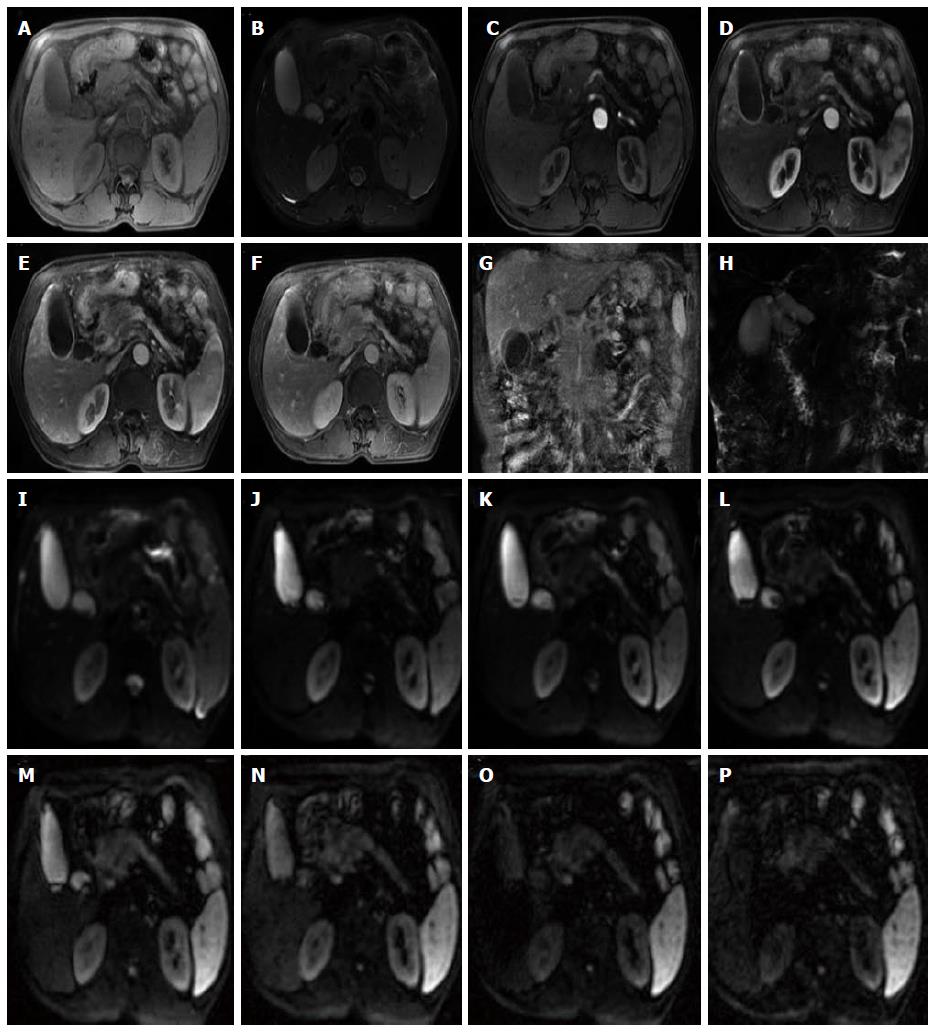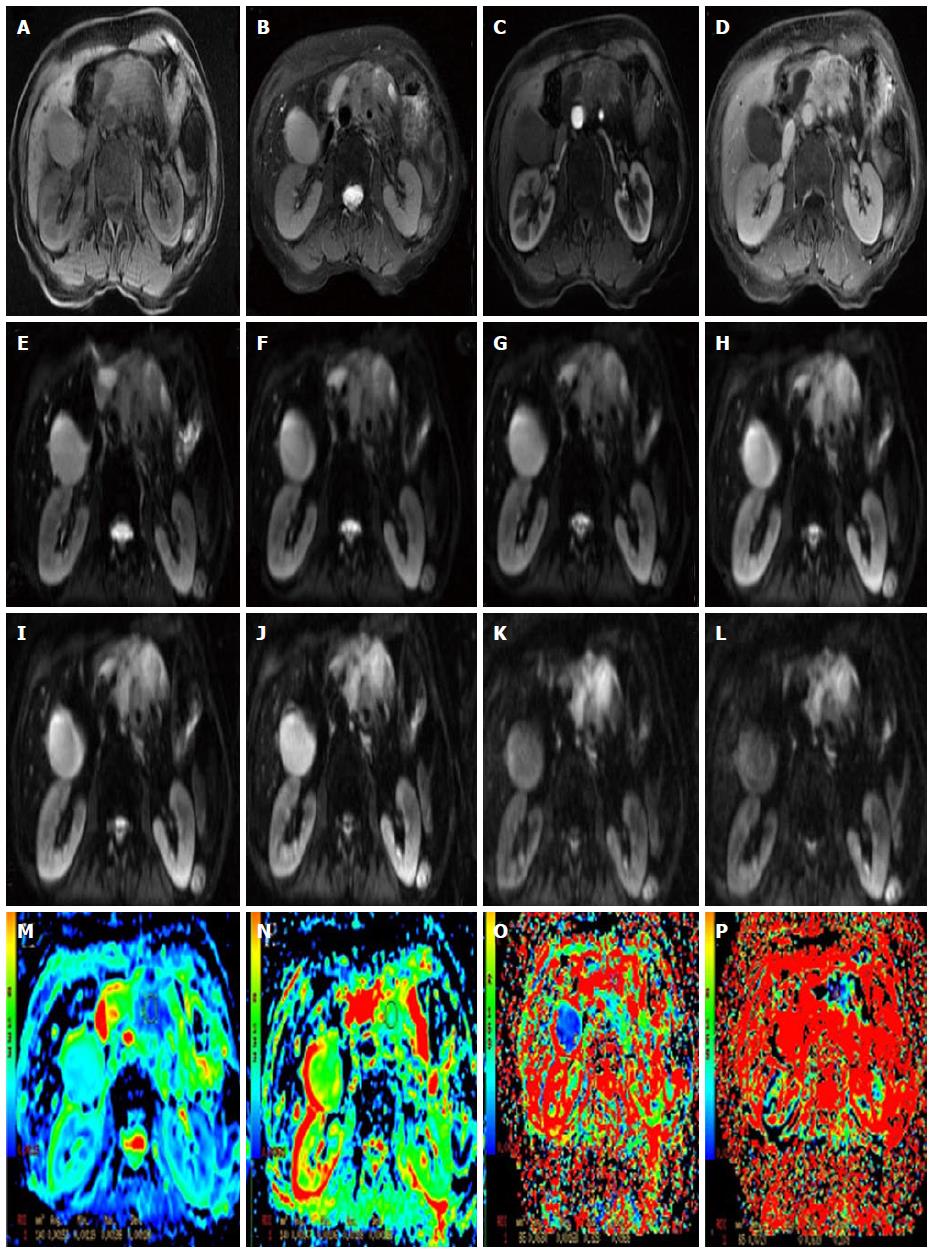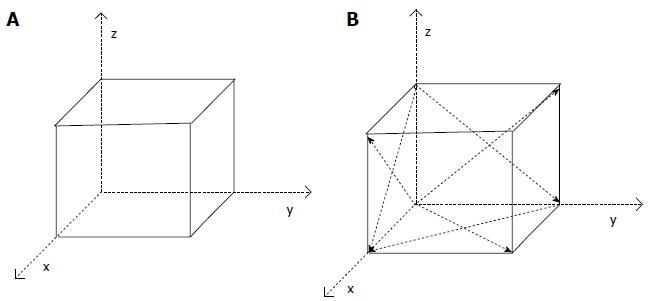Copyright
©The Author(s) 2015.
World J Radiol. Dec 28, 2015; 7(12): 424-437
Published online Dec 28, 2015. doi: 10.4329/wjr.v7.i12.424
Published online Dec 28, 2015. doi: 10.4329/wjr.v7.i12.424
Figure 1 Diffusion weighted imaging sequence.
Diffusion weighted imaging (DWI) applies the two motion-probing bipolar gradients on either side of the refocusing 180°pulse. The degree of diffusion weighting depends on the G (the amplitude of the gradients), δ (their duration) and Δ (the interval between gradients). This factor is quantitatively expressed by a parameter b, where b = γ2G2δ2 (Δ - δ/3) and γ is a constant of the gyromagnetic ratio. Assuming that the water molecules in tissues are motionless, the effects of the two motion-probing bipolar gradients can cancel each other. Thus, for the free molecular diffusion of water molecules, the displacement can be depicted by the DWI. RF: Radio frequency.
Figure 2 Images in a 47-year-old man with pancreatic moderately differentiated adenocarcinoma in the head of the pancreas (white arrows).
A: Axial T1-weighted fat-suppressed gradient-echo MR image; B: Axial T2-weighted fat-suppressed fast spin-echo MR image; C-E and G: Axial and coronal slab three-dimensional liver acquisition with volume acceleration dynamic contrast-enhanced; F: MRCP shows the biliary obstruction; H: The pathology of the lesion is shown as pancreatic moderately differentiated adenocarcinoma; I-P: Multi-b DWI imaging (b = 0, 50, 100, 300, 500, 800, 1000 and 1500). MR: Magnetic resonance; DWI: Diffusion weighted imaging; MRCP: Magnetic resonance cholangiopancreatography.
Figure 3 Images in a 63-year-old man with a focal lesion in the head of the pancreas.
MR imaging suggests that it is a malignancy. A: Axial T1-weighted fat-suppressed gradient-echo MR image; B: Axial T2-weighted fat-suppressed fast spin-echo MR image; C-G: Axial and coronal slab three-dimensional liver acquisition with volume acceleration dynamic contrast-enhanced; H: MRCP shows the biliary obstruction; I-P: Multi-b DWI imaging (b = 0, 50, 100, 300, 500, 800, 1000 and 1500). MR: Magnetic resonance; DWI: Diffusion weighted imaging; MRCP: Magnetic resonance cholangiopancreatography.
Figure 4 Images in a 65-year-old woman with a focal lesion in the neck of the pancreas.
Magnetic resonance (MR) imaging suggests that it is a malignancy. A: Axial T1-weighted fat-suppressed gradient-echo MR image; B: Axial T2-weighted fat-suppressed fast spin-echo MR image; C and D: Axial slab three-dimensional liver acquisition with volume acceleration dynamic contrast-enhanced; E-L: Multi-b DWI (b = 0, 50, 100, 300, 500, 800, 1000 and 1500); M-P: Standard ADC = 1.52 × 10-3 mm2/s, slow ADC = 1.39 × 10-3 mm2/s, fast ADC = 63 × 10-3 mm2/s and f = 7.2% generated by the post-processing from the multi-b DWI. DWI: Diffusion weighted imaging; ADC: Apparent diffusion coefficient.
Figure 5 Conventional diffusion weighted imaging (A): The bipolar gradients in three directions; the diffusion tensor imaging bipolar gradients in the six non-collinear directions (solid black arrows) (B).
Figure 6 Images in a 52-year-old man with a focal lesion in the body and tail of the pancreas.
MR imaging suggests that it is a malignancy. A: Axial T1-weighted fat-suppressed gradient-echo MR image; B: Axial T2-weighted fat-suppressed fast spin-echo MR image; C-G: Axial and coronal slab three-dimensional liver acquisition with volume acceleration dynamic contrast-enhanced; H: MRCP shows the dilated main pancreatic duct in the body and tail of pancreas; I-P: Multi-b DWI imaging (b = 0, 50, 100, 300, 500, 800, 1000 and 1500); Q and R: DTI (b = 500 and 800) using 30 diffusion gradients directions; S and T: DKI (b = 1500 and 2000) using 30 diffusion gradients directions. MR: Magnetic resonance; DWI: Diffusion weighted imaging; DKI: Diffusion kurtosis imaging; MRCP: Magnetic resonance cholangiopancreatography.
- Citation: Tang MY, Zhang XM, Chen TW, Huang XH. Various diffusion magnetic resonance imaging techniques for pancreatic cancer. World J Radiol 2015; 7(12): 424-437
- URL: https://www.wjgnet.com/1949-8470/full/v7/i12/424.htm
- DOI: https://dx.doi.org/10.4329/wjr.v7.i12.424














